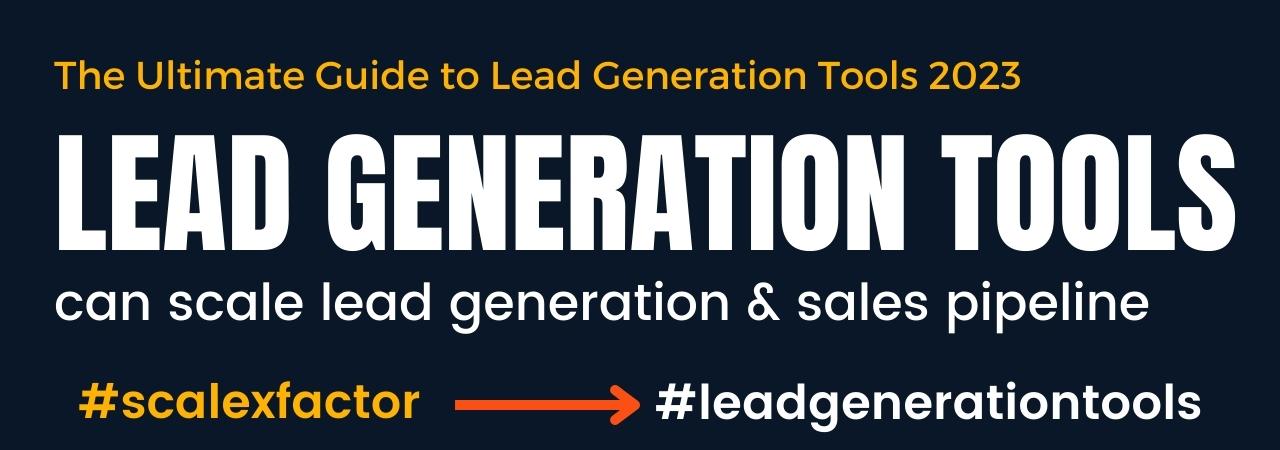In today’s digital landscape, lead generation is the lifeblood of any business looking to thrive. In this ultimate guide, we will delve deep into the world of lead generation tools in 2023. Whether you are a seasoned marketer or a newcomer to the field, this comprehensive guide will equip you with the knowledge and tools necessary to generate high-quality leads for your business.

In a world where digital interactions are increasingly prevalent, the concept of lead generation has taken center stage. The ability to attract, engage, and convert potential customers into loyal clients is the cornerstone of business success. This guide aims to unravel the intricacies of lead generation tools in 2023 and provide you with a roadmap to navigate this dynamic landscape.
Chapter 1: Understanding Lead Generation
What is Lead Generation?
Lead generation is the process of identifying and cultivating potential customers for your products or services. It involves capturing the interest of individuals or businesses who have expressed some level of interest in what you offer. These potential customers are referred to as leads, and they form the foundation of your sales pipeline.
Why is Lead Generation Important?
Lead generation is crucial for several reasons. It allows businesses to:
- Boost Revenue: More leads mean more potential sales, leading to increased revenue.
- Targeted Marketing: It enables businesses to focus their marketing efforts on individuals or businesses who are genuinely interested.
- Data Collection: Lead generation provides valuable data about potential customers, helping in personalized marketing.
- Business Growth: A robust lead generation strategy can lead to business expansion and market dominance.
Types of Leads
Not all leads are created equal. Understanding the different types of leads is essential for effective lead generation. The main types include:
- Marketing Qualified Leads (MQLs): These are leads that have shown interest in your product or service but may not be ready to buy.
- Sales Qualified Leads (SQLs): These are leads that have a higher likelihood of making a purchase in the near future.
- Cold Leads: These are individuals or businesses who have shown no prior interest in your offerings.
- Warm Leads: These leads have expressed some interest but may need nurturing before they convert.
Chapter 2: The Evolution of Lead Generation
In the digital age, lead generation has undergone a significant transformation. Let’s explore the evolution of lead generation methods and their impact on businesses.
Traditional vs. Digital Methods
Traditionally, lead generation relied heavily on methods such as cold calling, direct mail, and physical advertising. While these methods still have their place, digital lead generation has gained prominence. Digital methods include social media marketing, content marketing, and email campaigns.
The Role of Social Media
Social media platforms have become powerful tools for lead generation. With billions of users worldwide, platforms like Facebook, Twitter, and LinkedIn offer unparalleled opportunities to reach and engage potential customers. Leveraging social media for lead generation requires a strategic approach, including targeted advertising and content sharing.
Chapter 3: Key Strategies for Lead Generation
To effectively generate leads, businesses must employ various strategies. Here are some key ones:
Content Marketing
Content marketing involves creating valuable and relevant content to attract and engage your target audience. Blog posts, ebooks, infographics, and videos are examples of content that can be used to generate leads.
Email Marketing
Email marketing remains a potent tool for lead generation. Building an email list and sending targeted email campaigns can yield high conversion rates. Personalization and automation have also revolutionized email marketing.
SEO and Organic Traffic
Search Engine Optimization (SEO) is essential for increasing organic traffic to your website. By optimizing your website and content for search engines, you can attract potential customers actively searching for your products or services.
Paid Advertising
Pay-Per-Click (PPC) advertising, display ads, and social media advertising allow businesses to reach a broader audience quickly. These methods can be highly effective when executed correctly.
Chapter 4: Lead Generation Tools
In the digital era, numerous tools have emerged to streamline lead generation efforts. Let’s explore some of the essential lead generation tools for 2023.
CRM Systems
Customer Relationship Management (CRM) systems help businesses manage and nurture their leads. They store vital customer information, track interactions, and automate follow-up processes.
Marketing Automation Software
Marketing automation tools enable businesses to automate marketing tasks such as email campaigns, lead scoring, and segmentation. This streamlines the lead nurturing process.
Social Media Management Tools
Managing multiple social media accounts can be challenging. Social media management tools simplify this process by scheduling posts, analyzing engagement, and providing insights.
Email Marketing Platforms
Email marketing platforms offer a range of features, from list management to A/B testing. They empower businesses to create and send targeted email campaigns with ease.
Analytics and Tracking Tools
Understanding the effectiveness of lead generation efforts is crucial. Analytics and tracking tools provide valuable data on website traffic, conversion rates, and campaign performance.
Chapter 5: The Future of Lead Generation
As technology continues to advance, the future of lead generation holds exciting possibilities. Here are some trends to watch for in the coming years.
AI and Machine Learning
Artificial Intelligence (AI) and machine learning are poised to revolutionize lead generation. These technologies can analyze vast amounts of data to predict lead behavior and preferences.
Chatbots and Conversational Marketing
Chatbots and conversational marketing tools enable real-time interactions with potential customers. They can answer questions, provide information, and even schedule appointments, all without human intervention.
Chapter 6: Implementing Your Lead Generation Strategy
Now that we’ve explored the tools and strategies, it’s time to put your lead generation plan into action.
Setting SMART Goals
Before diving in, establish Specific, Measurable, Achievable, Relevant, and Time-bound (SMART) goals. These provide a clear roadmap for your lead generation efforts.
Creating Compelling Content
Content remains king in lead generation. Create content that resonates with your target audience, addresses their pain points, and provides solutions.
Nurturing Leads
Not all leads will convert immediately. Implement lead nurturing workflows to engage and educate leads until they are ready to make a purchase.
Measuring Success
To refine your lead generation strategy, regularly measure and analyze key performance metrics. Adjust your approach based on the data to improve results.
Case Studies
Real-world examples and case studies can provide valuable insights into successful lead generation strategies. Learn from others in your industry to fine-tune your approach.
Chapter 7: Common Lead Generation Pitfalls
While lead generation offers tremendous potential, it’s not without its challenges. Avoid these common pitfalls:
Lack of Targeting
Casting a wide net may seem like a good idea, but it can lead to wasted resources. Focus on targeting individuals or businesses most likely to convert.
Neglecting Mobile Users
With the majority of internet traffic coming from mobile devices, it’s essential to ensure your lead generation efforts are mobile-friendly.
Ignoring Data Privacy
Data privacy regulations, such as GDPR, require businesses to handle customer data responsibly. Failure to comply can result in severe consequences.
Overlooking Personalization
Personalized marketing is more effective than generic messages. Tailor your communications to the specific needs and preferences of your leads.
Chapter 8: Lead Generation Ethics
Ethical lead generation is not just a moral imperative; it’s also essential for long-term success.
Permission-Based Marketing
Obtain explicit consent from individuals before sending marketing communications. This builds trust and ensures compliance with data privacy laws.
GDPR Compliance
If you handle the data of European Union citizens, ensure your lead generation practices comply with the General Data Protection Regulation (GDPR).
Chapter 9: Staying Ahead of the Curve
To remain competitive, businesses must stay informed about industry trends and continuously adapt.
Industry Trends
Stay updated on the latest trends in lead generation and digital marketing. Embrace innovative approaches to stay ahead of competitors.
Continuous Learning
The digital landscape is ever-changing. Invest in ongoing education and training to keep your lead generation skills sharp.
FAQs
Q1: What are the best lead generation tools for small businesses?
Small businesses can benefit from various lead generation tools, including:
- CRM Systems: Customer Relationship Management systems like HubSpot and Salesforce help manage and nurture leads efficiently.
- Email Marketing Platforms: Tools like Mailchimp and ConvertKit enable targeted email campaigns.
- Social Media Management: Platforms like Buffer and Hootsuite help schedule posts and engage with potential leads.
- SEO Tools: Tools like SEMrush and Moz aid in optimizing online content for organic lead generation.
- Marketing Automation: Tools like Marketo and ActiveCampaign automate marketing processes.
Q2: How can I improve my email marketing for lead generation?
To enhance email marketing for lead generation:
- Segment Your List: Group your subscribers based on their interests and behaviors.
- Personalize Content: Tailor emails to individual preferences.
- A/B Testing: Experiment with subject lines, content, and timing to find what works best.
- Clear CTA: Include a compelling call to action that guides recipients.
- Mobile Optimization: Ensure emails are mobile-friendly.
Q3: What role does social media play in B2B lead generation?
Social media is valuable in B2B lead generation by:
- Networking: Building relationships with potential clients and industry peers.
- Content Sharing: Sharing informative content to establish expertise.
- Targeted Advertising: Running ads to reach specific B2B audiences.
- Lead Generation Forms: Collecting leads directly through social media platforms.
Q4: Is it better to focus on inbound or outbound lead generation?
The choice between inbound and outbound depends on your business and goals. Inbound focuses on creating content to attract leads, while outbound involves proactive outreach. Combining both can yield the best results.
Q5: How do I calculate the ROI of my lead generation efforts?
ROI for lead generation is calculated as (Net Profit from Leads – Cost of Lead Generation) / Cost of Lead Generation. It’s crucial to track expenses and revenue generated from leads.
Q6: What are the ethical considerations in lead generation?
Ethical lead generation involves:
- Permission-Based Marketing: Obtain consent before sending marketing communications.
- Data Privacy: Comply with data protection laws like GDPR.
- Transparency: Clearly communicate intentions and data usage.
Q7: Can chatbots effectively replace human interactions in lead generation?
Chatbots can handle routine interactions and provide 24/7 support, but they may not replace human interactions entirely, especially in complex or sensitive situations where a personal touch is essential.
Q8: How can I adapt my lead generation strategy to changing consumer behaviors?
To adapt to changing consumer behaviors:
- Stay Informed: Monitor industry trends and consumer preferences.
- Analyze Data: Use data analytics to understand customer behavior.
- Be Agile: Adjust strategies promptly based on insights.
Q9: What are the emerging technologies in lead generation?
Emerging technologies in lead generation include:
- AI and Machine Learning: Predictive analytics and personalized recommendations.
- Chatbots: Real-time interaction and lead qualification.
- Big Data Analytics: Improved customer profiling and targeting.
Q10: What are the key differences between B2B and B2C lead generation?
Key differences include:
- Sales Cycles: B2B often has longer, relationship-driven sales cycles; B2C can be more transactional.
- Audience: B2B targets businesses, while B2C targets individual consumers.
- Content: B2B content is often more technical and focused on solving business challenges, while B2C content is consumer-oriented.
Conclusion
In this ultimate guide to lead generation tools in 2023, we’ve covered the essential concepts, strategies, and tools that businesses need to succeed in the digital landscape. Lead generation is not a one-size-fits-all endeavor; it requires careful planning, continuous learning, and ethical practices. By following the insights and recommendations provided in this guide, you’ll be well-equipped to generate high-quality leads and drive your business forward.




